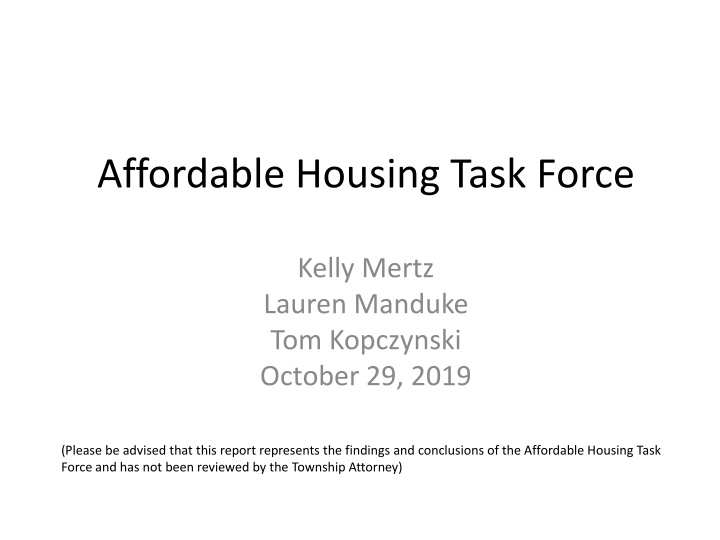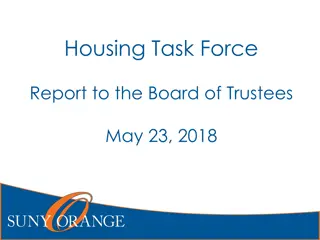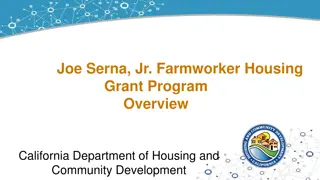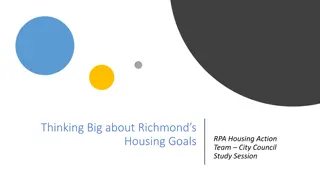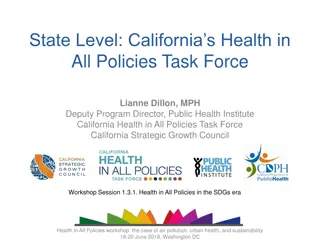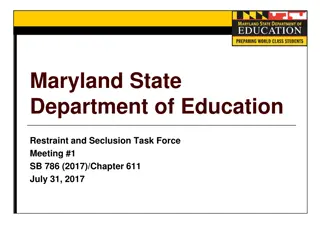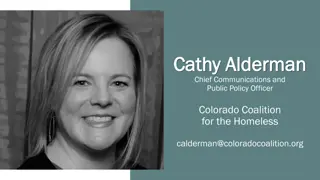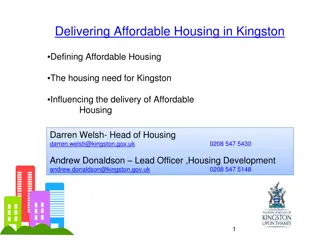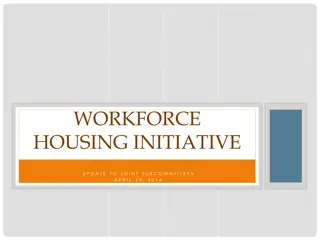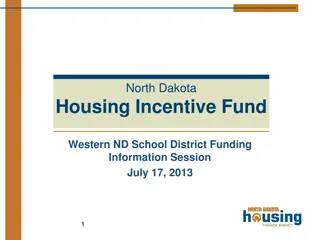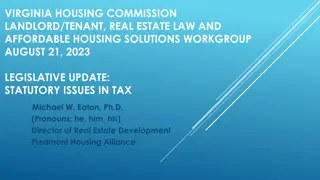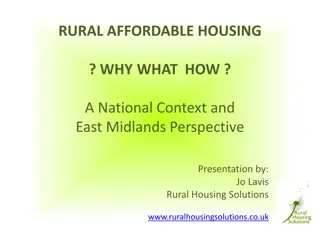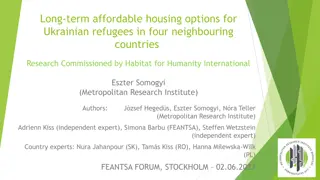Affordable Housing Task Force Report Overview
This report from the Affordable Housing Task Force delves into the concept of affordable housing in New Jersey, outlining the criteria for affordability, eligibility categories based on income levels, and a brief history of affordable housing regulation in the state. It covers crucial milestones such as the Mount Laurel rulings and the establishment of the Council on Affordable Housing (COAH) to address the state's affordable housing needs.
Download Presentation

Please find below an Image/Link to download the presentation.
The content on the website is provided AS IS for your information and personal use only. It may not be sold, licensed, or shared on other websites without obtaining consent from the author.If you encounter any issues during the download, it is possible that the publisher has removed the file from their server.
You are allowed to download the files provided on this website for personal or commercial use, subject to the condition that they are used lawfully. All files are the property of their respective owners.
The content on the website is provided AS IS for your information and personal use only. It may not be sold, licensed, or shared on other websites without obtaining consent from the author.
E N D
Presentation Transcript
Affordable Housing Task Force Kelly Mertz Lauren Manduke Tom Kopczynski October 29, 2019 (Please be advised that this report represents the findings and conclusions of the Affordable Housing Task Force and has not been reviewed by the Township Attorney)
What is Affordable Housing (AH)? Affordable housing, unlike market rate housing, has affordability controls limiting the price for at least 30 years. In NJ, housing is defined as affordable if a household is spending approximately 30% of the household s gross income on housing costs. The majority of AH units are rentals.
Who qualifies for AH? Eligibility is a function of a household s income versus the region s median family income. 3 categories: Very Low: Household income is less than 30% of the regional median. Low: Household income is less than 50% of the regional median. Moderate: Household income is between 50% and 80% of the regional median. BT regional (Somerset Hunterdon Middlesex) median income is $118,300.
Some history of affordable housing in NJ Mount Laurel I (1975). Municipalities must, by its land use regulations, make realistically possible the opportunity for an appropriate variety and choice of housing for all categories of people who may desire to live there including those of low and moderate income. The decision prohibits municipalities from using zoning powers to prevent the potential for the development of affordable housing.
Mount Laurel II (1983) The NJ Supreme Court permits builders remedy lawsuits. Builders can sue municipalities to force compliance to court mandated quotas. A builder potentially would be permitted to build more units at higher density in a non-compliant town, in the location where the builder wants, and not necessarily where the town might want. A portion of the builder s units is required to be affordable to persons of low and moderate income.
Mount Laurel III 1985: Fair Share Housing Act passed. 1986: Council on Affordable Housing created. The Supreme Court orders builders remedy lawsuits transferred to the jurisdiction of COAH. 1986 2015: COAH adopts 2 rounds of rules to address NJ s AH need. Gridlocks on round 3. During this time the Growth Share model and Regional Contribution Agreements are abolished.
Mount Laurel IV 2015: COAH is abolished. Builders remedy lawsuits return to the trial courts. 2018: Judge Jacobson defines new methodology for NJ s round 3 AH need. The ruling employs estimates of: Households and wealth Jobs and population growth Available acreage
BT Round 3 Fair Share Plan Round 3 spans 1987-2025. The plan features: Rehabilitation obligation of 44 units. Prior Round obligation of 508 units. Major contributors are found in the VA, Society Hill and the Cedars. Gap Present Need of 435 units. Major contributors are found in prior RCAs, the VA, Society Hill, and the Cedars. Prospective Need of 438 units. Major contributors are Valley Brook II, Dewy Meadow, and Mountainview. In each round, BT has honored its obligation as outlined by COAH and now by the court.
Key Players Fair Share Housing Center Founded in 1975, the FSHC is a public interest organization devoted to defending the enforcement of the Mount Laurel doctrine. Judge Thomas C. Miller is a judge on Vicinage 13 of the New Jersey Superior Court, Somerset County. He was confirmed to court in April 2011 following his appointment by Governor Chris Christie. Adam M. Gordon, Esq. (Fair Share Housing Center) Court-appointed Special Masters
Consequences of Non-Compliance Builder Remedy Lawsuits Mechanism allowed by Courts to prosecute municipalities for exclusionary zoning practices Developers of affordable housing are not like common development communities Profits made both in the short term (construction) and long term (rent) Control location and density if prevail Often results in new zoning Often involves PILOT Examples of Successful Builder Remedy Suits Englewood Cliffs Bad faith finding by Court Developer allowed to proceed with development of former Unilever campus Abolished Englewood Cliffs immunity opening the door for additional developers to developer other locations in addition to Unilever
Consequence of Non-Compliance (continued) Toll Bros. The Hills Late 1980 s/early 1990 s - Bedminster builders remedy 1,800 acres formerly known as the Watchung Hills Resulted in almost 5,000 units 237 Mount Laurel units built in Phillipsburg paid by developer as part of Bernards Twp s portion of its development. Remaining 315 units, 225 built as part of Bernards Twp projects, 43 proposed for here and elsewhere Twp. received credit for 47 existing residents.
Consequence of Non-Compliance (continued) Toll Bros., Inc. v. Twp. of West Windsor New Jersey Supreme Court, 2002 Developer initiates litigation against Twp., mayor, and planning board for exclusionary zoning. Trial Court granted remedy and Twp. appealed. NJ Supreme Court held: Market demand is a factor. Twp. zoning ordinance(s) which relied almost exclusively on multi- family housing as vehicle for development of inclusionary projects did not satisfy Mt. Laurel. Twp. s sewer policies were impediment to compliance. Developer was entitled to builders remedy.
Consequence of Non-Compliance (continued) Landmark at Radburn, L.L.C. v. Borough of Fair Lawn Builder remedy for exclusionary zoning Found municipality s future plans to rezone certain cites insufficient Court found that it is not too burdensome to require municipalities to actually adopt, by ordinance, all components of the regulatory scheme for realistic opportunities for affordable housing. Declared Fair Lawn s land use regulations invalid Appointed a Special Master pending appeal
Consequence of Non-Compliance (continued) Bottom line Non-Compliance is not a viable option. It is NEVER beneficial to allow the municipality to be subject to a builder s remedy situation: Municipality loses control of location Municipality loses control over density of housing Overreach Dangerous precedent
Can BT manage its own AH? Requires tremendous resources including housing authority or similar body Condemnation proceedings are time consuming and expensive Lack of suitable available locations to address the needs and requirements of the mandates Taxpayers would effectively be footing the bill for all operations / management of municipality-owned locations
Legislative Change 114 bills have been presented to the State legislature. Three of them propose removal of the AH process from the Courts. A1644 - Allows municipalities to establish AH preference for their residents. A1648 - Establishes additional factors for municipal adjustment used in calculating fair share AH obligations; provides population-based cap for these obligations. A4471 - Establishes Subcommittee on Affordable Housing Needs within Joint Committee on Housing Affordability ; requires subcommittee to make determinations concerning AH needs.
Summary Affordable Housing eligibility is composed of a range of income levels that vary from region to region. Transparency is the goal, but challenged in some instances by immunity lawsuits, confidentiality requirements of mediation / settlement, and/or Court- order. Builders Remedy lawsuits should be avoided at all costs. The majority of BT s current residential development is being driven by court mandated affordable housing obligations.
Helpful Links NJ guide to AH: https://www.state.nj.us/dca/divisions/codes/publications/guide.html Detailed timeline: http://woolsonlaw.com/docs/timeline.pdf Judge Jacobson ruling: http://fairsharehousing.org/images/uploads/Opinion_on_Fair_Share_Met hodology.pdf BT s 2018 Housing Plan Element: http://www.bernards.org/Resolutions/2018/2018- 0434PlanAndElement.pdf Judge Miller s ruling: http://www.bernards.org/township%20committee/Document/2018/Settl ementWithFairShareHousing2018-11-05-doc.pdf NJ League of Municipalities analysis: http://www.nassaucap.com/wp- content/uploads/2016/01/NJ-St.-League-of-Municipalities-Report-Nassau- Capital-Advisors-09.22.2015.pdf Fair Share Housing Center: http://fairsharehousing.org/
List of Representatives Gov. Murphy: https://www.nj.gov/governor/contact/all/ - no email address can be obtained, have to go thru website constituent.relations@nj.gov State Reps: Tom Malinowski District 7 (Bernards Twp., Bernardsville, Berkeley Heights, Far Hills, Long Hill Twp. , New Providence, Warren Twp., Watchung): eric.hamilton@mail.house.gov Mikie Sherrill District 11 (Harding Township) - no meal address can be obtained, have to go thru website https://sherrill.house.gov Somerset County Freeholders: FreeholdersOffice@co.somerset.nj.us (goes to all) Union County Freeholders: sgranados@ucnj.org bkowalski@ucnj.org kimberly.mouded@ucnj.org andrea.staten@ucnj.org aestrada@ucnj.org agarretson@ucnj.org chudak@ucnj.org amirabella@ucnj.org rebecca.williams@ucnj.org Morris County Freeholders: douglasc@co.morris.nj.us johnk@co.morris.nj.us heatherd@co.morris.nj.us kathrynd@co.morris.nj.us thomasm@co.morris.nj.us stephens@co.morris.nj.us deborahs@co.morris.nj.us
List of Representatives (Contd.) District 21: Berkeley Heights, Bernards, Chatham Borough, Cranford, Far Hills, Garwood, Kenilworth, Long Hill, Mountainside, New Providence, Roselle Park, Springfield (Union), Summit, Warren, Watchung, Westfield Senator Thomas Kean Jr: senkean@njleg.org Assemblyman Jon M. Bramnick: AsmBramnick@njleg.org Assemblywoman Nancy F. Munoz: AswMunoz@njleg.org District 25: Bernardsville, Boonton, Boonton Township, Chester Borough, Chester Township, Denville, Dover, Mendham Borough, Mendham Township, Mine Hill, Morris, Morristown, Mount Arlington, Mountain Lakes, Netcong, Randolph, Rockaway Borough, Roxbury, Victory Gardens, Washington (Morris), Wharton Assemblyman Anthony M. Bucco: asmbucco@njleg.org Assemblyman Michael Patrick Carroll: asmcarroll@njleg.org District 27: Caldwell, Chatham Township, East Hanover, Essex Fells, Florham Park, Hanover, Harding, Livingston, Madison, Maplewood, Millburn, Roseland, South Orange, West Orange Senator Richard Codey: sencodey@njleg.org Assemblyman John F. McKeon: asmmckeon@njleg.org Assemblywoman Mila Jasey: aswjasey@njleg.org State House Leaders: Senator Stephen M. Sweeney: asmsweeney@njleg.org Assemblyman Craig J. Coughlin: asmcoughlin@njleg.org (Assembly Speaker) Housing and Community Development Committee: Assemblyman Benjie E. Wimberly: asmwimberly@njleg.org (Deputy Speaker) Assemblywoman Annette Chaparro: aswchaparro@njleg.org Assemblyman Robert D. Clifton: asmclifton@njleg.org Assemblywoman Mila M. Jasey: aswjasey@njleg.org Assemblywoman Holly T. Schepisi: aswschepisi@njleg.org Assemblywoman Shanique Speight: aswspeight@njleg.org NJ League of Municipalities: Michael Darcy, Executive Director Mdarcy@njlm.org
